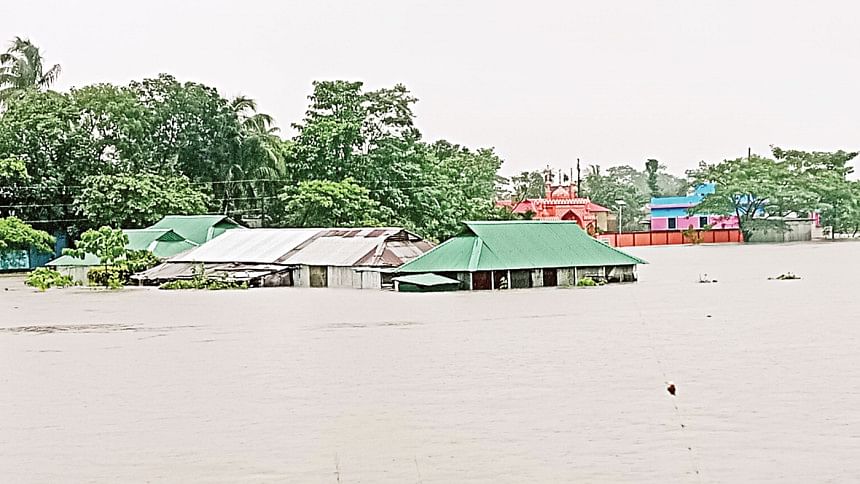Floods In Sylhet: Farmers count the losses

As soon as the second wave of flash floods hit Sylhet in the early hours of June 17, Moklisur Rahman, a fish farmer in Gowainghat upazila, knew he was going to lose all his fish, which he had worked very hard to raise in his three ponds.
"I immediately rushed to the ponds, but it was too late for anything to be done. Within hours, I lost fish worth at least Tk 7 lakh," lamented Moklisur, a resident of the upazila's Nayagram Uttar village.
Like him, thousands of fish farmers in Sylhet, Sunamganj, and Moulvibazar have lost their prized possessions as the flood washed away as many as 13,650 ponds, said the divisional fisheries department.
Abdal Miah of Chanpur village in Sylhet's Fenchuganj upazila said, "Even as my house was flooded to the waist, we stayed back to protect the cattle. But, sadly, we could do nothing about the fish in the pond worth at least Tk 50,000."
Md Arif of Rahimpur village in Moulvibazar's Kamolganj upazila said, "After the dyke of the Dhalai River broke and the flash flood inundated the village, I lost fish worth around Tk 1 lakh. I now have nothing."
Fish farmers in the region have incurred a substantial loss of Tk 133.61 crore, of which Tk 101.18 crore has been lost in the Sylhet district alone, according to the divisional fisheries department.
Md Anowar Hossain, deputy director of the Department of Fisheries in Sylhet, said, "We are now keeping an eye on the sanctuaries so that we can protect the various fish species that have been washed away from local farms and ponds during the flash floods."
Meanwhile, the divisional agricultural extension department reports that farmers in the region are looking at a significant loss of paddy and vegetables, as over 26,000 hectares of farmland have been submerged.
The flood-affected croplands comprise 17,460 hectares of Aush paddy, 1,123 hectares of Aush seedbed, 167 hectares of Aman seedbed, and 7,656 hectares of vegetables.
Mati Lal Halder, a sub-assistant agriculture officer at the divisional DAE, said, "We have not estimated the financial loss yet because a large amount of paddy and vegetables may survive once the water recedes. We will estimate the financial loss once the floodwaters have receded completely."
With only a trace of rainfall and occasional sunny skies, the water level of the Surma River was rapidly receding yesterday, improving the flood situation in vast areas.
The river at Sylhet City Point fell below the danger mark yesterday morning, while it flowed slightly above it at other points.
The flood situation in Moulvibazar and Habiganj is also starting to get better as the water levels in the Manu, Khowai, and Dhalai rivers fell below the danger marks.
However, the Kushiyara River continued to be above the danger level at Fenchuganj point as well as at all other points in Sylhet and Moulvibazar.
Just 2mm of rain fell on Sylhet city in the 24 hours till yesterday morning, while Moheshkhola in Sunamganj recorded the most at 121mm.
The flood situation in the Sylhet region is expected improve in the next 72 hours, according to yesterday morning's forecast by the Flood Forecasting and Warning Centre and Water Development Board.
A total of 21.08 lakh people have been affected by the flash floods in Sylhet, Sunamganj, and Moulvibazar districts with 53,244 people residing in the shelter centres as of yesterday afternoon.
In the past three weeks, Sylhet city has been inundated five times due to heavy rains, affecting hundreds of areas and causing untold suffering to the dwellers.
Earlier, on May 29, heavy rains and hill torrents from upstream caused flooding in Sylhet. The flood situation began to normalise on June 8.
However, continuous rains starting in the early hours of June 17 led to another flood in the district.
Prior to this, in May, floods were caused by hill torrents and rains from upstream in India.


 For all latest news, follow The Daily Star's Google News channel.
For all latest news, follow The Daily Star's Google News channel. 



Comments